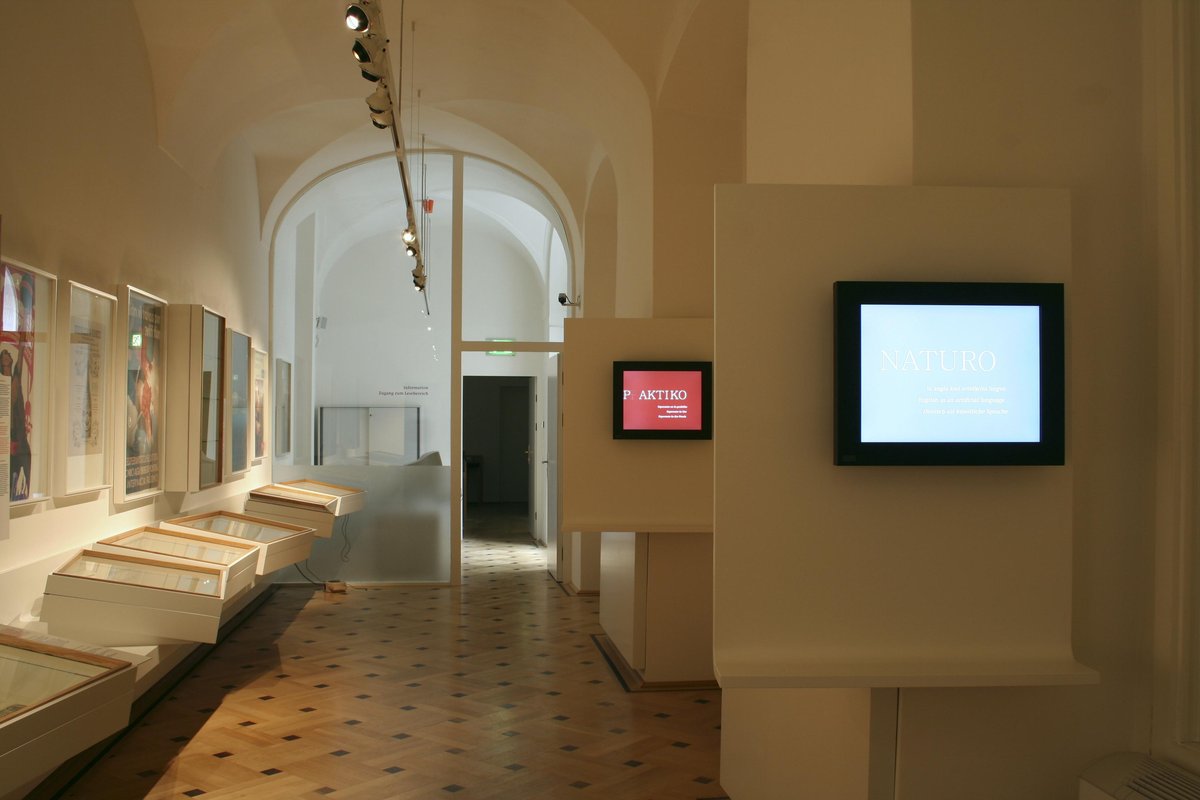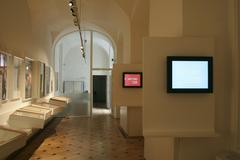
Department of Planned Languages and Esperanto Museum Vienna: Visiting Hours, Tickets, and Guide
Date: 14/06/2025
Introduction
Nestled in the heart of Vienna, the Department of Planned Languages and Esperanto Museum at Palais Mollard-Clary offers a distinctive exploration into the world of constructed languages, with a special emphasis on Esperanto—the most widely spoken international auxiliary language. Established in 1927 and part of the Austrian National Library, the museum preserves an extensive archive chronicling the development, cultural significance, and global aspirations of Esperanto and other planned languages such as Volapük, Ido, and Interlingua. Today, housed in a 17th-century Baroque palace, it stands as one of the world’s oldest and most comprehensive institutions dedicated to interlinguistics and linguistic innovation (Austrian National Library; esfconnected.org).
With a collection exceeding 35,000 printed volumes, thousands of manuscripts, photographs, and artifacts, the museum provides engaging, multilingual exhibitions and interactive experiences. These displays illuminate Esperanto’s origins, its journey through periods of suppression and resurgence, and its ongoing role in fostering international communication and peace. Perfectly located near iconic Viennese landmarks such as the Hofburg Palace and St. Stephen’s Cathedral, the Esperanto Museum is a scholarly treasure trove and an accessible cultural destination for linguists, history enthusiasts, families, and travelers. This guide compiles essential visitor information—covering hours, ticket options, accessibility, digital resources, and nearby attractions—to ensure a well-rounded and enriching visit (visitamuseum.info; Triphobo).
Table of Contents
- Introduction
- Historical Background and Evolution
- Museum Collections and Highlights
- Visitor Information
- Exhibitions and Visitor Experience
- Digital Resources and Virtual Access
- Nearby Attractions
- Frequently Asked Questions (FAQs)
- Conclusion and Recommendations
- References
Historical Background and Evolution
Origins and Founding
Founded in 1927 as part of the Austrian National Library, the Esperanto Museum was established to preserve and showcase the burgeoning international interest in constructed languages, especially Esperanto. Created in 1887 by Dr. Ludwig Lazar Zamenhof, Esperanto was designed as a politically neutral, easy-to-learn language to foster international understanding. The museum’s early collections included rare books, periodicals, and artifacts that documented the rapid growth of the Esperanto movement, which by the 1920s had spread widely across Europe and beyond (esfconnected.org).
Notably, Vienna served as a major center for Esperanto activity, hosting over 70 language courses in 1922, with lessons broadcast on Radio Vienna and published in local media—even the police received specialized instruction (visitamuseum.info). The museum’s founding was inspired by Felix Zamenhof and brought to life by Hugo Steiner. Despite forced closure by the Gestapo in 1938, the museum triumphantly reopened in 1947, symbolizing the resilience of the Esperanto community.
Expansion and Mission
In 1990, the museum expanded its remit and became the Department of Planned Languages, documenting a wide array of constructed languages beyond Esperanto. Today, its collection encompasses approximately 500 planned languages, including contemporary creations such as Klingon and Dothraki, reflecting ongoing human fascination with language invention (visitamuseum.info). Since 2005, the museum has been located in Palais Mollard-Clary, alongside the Globe Museum and the Department of Music, enhancing its connections with Vienna’s rich cultural landscape (onb.ac.at).
Museum Collections and Highlights
The Esperanto Museum holds the world’s largest specialized library on planned languages, featuring:
- 35,000+ printed volumes
- 40,000 flyers and pamphlets
- 25,000 newspaper articles
- 22,000 photographs
- 10,000 handwritten texts and manuscripts
- 3,700 journals
- 3,500 museum artifacts (including branded everyday objects, maps, and memorabilia)
- 1,500 posters
- 1,200 sound recordings
The collection documents not only Esperanto, but also a wide spectrum of planned languages, both historical and fictional. Many items have been digitized and are accessible online, expanding access to researchers and enthusiasts worldwide (Austrian National Library).
Visitor Information
Visiting Hours
- Tuesday to Sunday: 10:00 AM – 6:00 PM
- Closed: Mondays and public holidays
Check the official museum website for updates on special closures.
Ticket Prices
- Adults: €8
- Students/Seniors: €5
- Children under 19: Free
Tickets grant access to the Austrian National Library museums and can be purchased online or at the entrance.
Accessibility
The museum is fully wheelchair accessible, with step-free entry, elevators, accessible restrooms, and staff assistance available. Lockers are provided for visitor convenience (visitamuseum.info).
How to Get There
- Address: Palais Mollard, Herrengasse 9, 1010 Vienna, Austria
- U-Bahn: Herrengasse (U3 line)
- Tram: Lines 1, 2, D, and J (nearest stops within walking distance)
- Bus: Lines 1A, 2A, 3A
- The museum is easily reached on foot from Vienna’s city center and is close to major attractions such as the Hofburg Palace and St. Stephen’s Cathedral (Triphobo).
Best Time to Visit
Weekday mornings are less crowded, offering a more relaxed and immersive experience.
Exhibitions and Visitor Experience
Permanent Exhibition
The permanent exhibit traces Esperanto’s journey from its creation in 1887 to its role in contemporary society. Key highlights include:
- The first Esperanto textbook by Zamenhof
- Interactive media stations with digital resources and music
- Cultural artifacts, historical posters, and everyday objects branded in Esperanto
- Displays on other planned languages, from Hildegard of Bingen’s Lingua Ignota to fictional tongues like Klingon
Temporary and Thematic Exhibitions
Rotating exhibitions spotlight themes such as language planning in literature and film, or Esperanto’s impact on international diplomacy. Special events, lectures, and workshops further enrich the visitor experience.
Multimedia and Accessibility
Audio guides are available in German, English, and Esperanto. Interactive installations and digital timelines enhance engagement for all ages. The museum’s inclusive approach ensures accessibility for a diverse audience (onb.ac.at).
Digital Resources and Virtual Access
Since 2006, over 28,000 items have been digitized—including photographs, posters, books, and periodicals—available through the Austrian National Library’s digital portals. Online catalogues such as QuickSearch and Trovanto provide remote access to the collections. Selected exhibitions are also accessible virtually, with multilingual support in English, German, and Esperanto (Austrian National Library).
Nearby Attractions
Maximize your visit by exploring other Vienna highlights nearby:
- Hofburg Palace (5-minute walk)
- St. Stephen’s Cathedral (10-minute walk)
- Albertina Museum (10-minute walk)
- Vienna State Opera (15-minute walk)
For refreshments, Café Central—famed for its grand architecture and Viennese pastries—is just a short stroll away.
Frequently Asked Questions (FAQs)
Q: What are the Esperanto Museum’s opening hours?
A: Tuesday to Sunday, 10:00 AM – 6:00 PM; closed Mondays and public holidays.
Q: How much is admission?
A: Adults €8, students/seniors €5, children under 19 free.
Q: Is the museum suitable for children?
A: Yes, interactive exhibits engage younger visitors and children under 19 enter free.
Q: Are guided tours available?
A: Yes, tours can be arranged in multiple languages by prior booking.
Q: Is the museum wheelchair accessible?
A: Yes, with step-free access and accessible facilities.
Q: Can I take photos inside?
A: Photography is allowed in most areas without flash; look for any signage regarding restrictions.
Q: Is there a gift shop?
A: Yes, featuring books and Esperanto-themed souvenirs.
Q: Can I access digital resources from home?
A: Yes, thousands of digitized items and virtual exhibitions are available via the Austrian National Library’s website.
Conclusion and Recommendations
The Department of Planned Languages and Esperanto Museum in Vienna stands as a vital institution preserving the legacy and ongoing evolution of constructed languages, particularly Esperanto. With unparalleled collections, thoughtfully curated exhibitions, and a commitment to accessibility and education, the museum offers visitors a unique opportunity to explore linguistic creativity and intercultural dialogue in a historical Viennese setting.
Whether exploring the physical archives and interactive displays at Palais Mollard-Clary or accessing the vast digital collections online, visitors gain insight into the utopian ideals of international understanding and peace. Practical visitor amenities, including guided tours, multilingual audio guides, and proximity to other cultural landmarks, ensure a rich and varied experience for families, scholars, and curious travelers alike.
For the latest information on visiting hours, ticketing, special events, and digital resources, consult the official Austrian National Library website. Consider using the Audiala app for an enhanced audio guide experience. By engaging with this remarkable museum, you not only discover the fascinating history of planned languages but also participate in a broader conversation about linguistic diversity and global connection.
References
- Visiting the Esperanto Museum Vienna: Hours, Tickets, History & Tips, 2021, esfconnected.org (esfconnected.org)
- Esperanto Museum in Vienna: Visiting Hours, Tickets & Historical Significance, 2022, visitamuseum.info (visitamuseum.info)
- Visiting the Esperanto Museum Vienna: Hours, Tickets, Exhibitions, and Digital Access, 2023, onb.ac.at (Austrian National Library)
- Visitor Experience and Practical Information: Your Guide to Visiting the Esperanto Museum in Vienna, 2024, Triphobo & The Vienna Blog (Triphobo; The Vienna Blog)






















































































































































